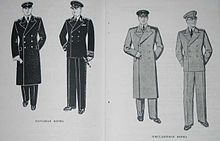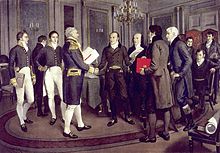- Diplomatic uniform
-
Diplomatic uniforms are ornate uniforms worn by diplomats – ambassadorial and consular officers – at public occasions. Introduced by European states around 1800 and patterned on court dress, they were abandoned by most countries in the 20th century, but diplomats from some countries retain them for rare formal occasions.
Contents
History
Up until the 18th century, diplomats (who usually belonged to the high nobility) wore their own court clothing to solemn occasions. Diplomatic uniforms were first introduced by France in 1781 and widely adopted by other European states around 1800 in the course of administrative reforms undertaken as a response to the French Revolution and the Napoleonic Wars. In several countries, diplomatic uniforms were among the first civilian uniforms to be issued. Apart from saving diplomats (who now increasingly were not independently wealthy) the expense of maintaining a full court wardrobe, diplomatic uniforms served to emphasize the importance of the office and to deemphasize the person of its holder.[1]
Several non-European courts adopted European-style diplomatic uniforms during the 19th century. Notably, Japan during the Meiji Revolution introduced European uniforms instead of traditional clothing for all officials in 1872.[1] The final period during which the majority of diplomatic services retained formal uniforms for the accredited members of their overseas missions was that prior to World War II. A detailed study of contemporary uniforms, both military and civil, published in 1929[2] gives descriptions of the diplomatic uniforms still being worn by representatives of the majority of states then in existence. These included most European nations and a number of Latin American and Asian countries. It is however noted that several states which had only been created following World War I, had not adopted diplomatic uniforms and that others had discarded them. The uniforms described are nearly all of the traditional style of bicorne hat and tailcoat with braiding according to grade, from third secretaries to ambassadors. Consular staff were less likely to have authorised uniforms than their diplomatic colleagues.
While most countries abandoned diplomatic uniforms at some time during the 20th century, several have retained them: a photo of the 2001 New Year's reception at the Vatican shows the ambassadors of Monaco, the Netherlands, Thailand, the United Kingdom, Spain, France, and Belgium all clad in diplomatic uniform.[1]
Design
Diplomatic uniforms generally followed 19th century court fashion and usually included a tailcoat with standing collar, breeches or pantaloons, a sword and a two-cornered plumed hat ("bicorne"). There were normally at least two versions, a dress uniform for ceremonial events and a simpler version for less formal occasions which nevertheless required the use of uniform dress.[1] Unlike their military and naval counterparts, diplomats did not wear uniforms for everyday purposes but substituted the appropriate civilian clothing.
Diplomatic uniforms were usually richly embroidered with gold similar to the uniforms of high court officials. Diplomatic rank was distinguished by the amount and quality of the embroidery. In contrast to military uniforms, which underwent rapid changes throughout the 19th and early 20th century, the diplomatic uniforms tended to keep their traditional design.[1] While the uniforms of the different foreign services generally shared the common features noted above, there were considerable national differences, though often of minor detail. Thus, as random examples, French ambassadors were distinguished by pearl handled court swords with gold and silk frogs (sword attachments), their Portugese colleagues by oak leaves and accorns represented in gold embroidery on their dress coats, while Belgian ministers wore chapeaus with white plumes plus blue and gold waist sashes.
Diplomatic uniforms by country
Germany
In 1817, Prussian diplomats received as uniforms dark blue tail coats with cuffs and a standing collar of black velvet, decorated with oak leaf scrolls embroidered in gold. In 1888, the German Empire introduced the Altbrandenburgischer Waffenrock, a long military-style coat, as the general state uniform for high-ranking officials.[1] Military uniform was worn instead of court uniform by military officers and by those political figures who were reserve officers, which included most diplomats: it was practically impossible under the Empire for one to be a civil servant or a state secretary of ministerial rank without being a reserve officer.
Diplomatic uniforms were abandoned under the Weimar Republic, but the Nazi regime, which had a general fondness for uniforms, reintroduced them. The stage designer Benno von Arent designed the "startling" Nazi diplomatic uniform, consisting of a dark blue tailcoat whose modern lapels were embroidered with silver oak leaves, a silver sash, a silver aiguillette and a small dagger.[1]
Russia and the Soviet Union
In 1834, the Russian Empire introduced diplomatic uniforms. After the Russian revolution, a document entitled "Short Instruction on Adhering to the Accepted Bourgeois Society Etiquette Rules" by the People's Commissariat for Foreign Affairs (NKID) instructed the revolutionary diplomats to wear jackets on formal occasions. From 1923 to 1924, Moscow newspapers debated whether the wearing of civilian Western dress and thereby "bourgeois society symbols, which are totally alien to the spirit of the Workers' and Peasants' State" was appropriate, and there were calls for a Soviet diplomatic uniform to be introduced.[3]
But it was not until 1943 that a uniform was introduced for NKID staff, consisting of a three-piece uniform suit with gold-plated buttons and shoulder straps. The everyday uniform was grey and the dress uniform, which included a dagger, was black. Accoutrements included a coat, raincoat, hat and an ornate cap with the diplomatic insignia.[4] The black dress uniform was similar to the Nazi SS uniform; the Soviet diplomat Victor Israelyan recounted that during World War II he was once given the Hitler salute and a loud "Heil Hitler!" by a German prisoner of war who mistook him for an SS officer.[4]
The Soviet diplomatic uniform was officially discontinued in 1954; only ambassadors continued to wear the dress uniform, without the dagger, on special occasions.[3][4] After the fall of the Soviet Union in 1991, that practice stopped as well until at least 2001.[3] Senior officials of the Russian Foreign Ministry now retain a dark blue suit with gold collar braiding for wear on formal occasions.[citation needed]
United Kingdom
British diplomats wore the official court uniform consisting of a dark blue button-down high-collar jacket with gold oak-leaf embroidery on the chest, cuffs and long tails; white breeches, or dark blue trousers with gold stripes; and a cocked hat with white ostrich plumes. A simplified white uniform was worn in tropical postings.
Ambassadors wore first class court uniform, which was based on the Windsor uniform, modified by the dress of the Marshal of France. It had a dark blue single-breasted tail coat, lined with black silk, the stand collar and gauntlet cuffs having scarlet (later black and then blue) velvet facings, gilt buttons, waistcoat, breeches or trousers. Members of the Consular Service wore court uniforms with modifications according to their diplomatic rank. The King's or Queen's Foreign Service Messengers were entitled to 5th class court uniform, upgraded to 4th class in 1929.
By the end of the 20th century the use of this uniform had greatly diminished. Within Her Majesty's Diplomatic Service only ambassadors retained a simplified version for wear on such occasions as the presentation of credentials and then only when accredited to certain countries. Until about 1965 Foreign Office Regulations and Consular Instructions had required even junior foreign service officers to acquire this formal dress following completion of their probation period.
United States
American diplomats were first issued uniforms for the mission concluding the 1814 Treaty of Ghent; these consisted of a blue gold-embroidered coat, white breeches and stockings, a sword and a cocked hat with a black cockade. U.S. diplomats routinely designed and wore uniforms of their own choosing until 1817, when the State Department formally prescribed a uniform for ministers based on the one issued for the Ghent mission.[5] This uniform was recommended for use by all ministers abroad by then Secretary of State John Quincy Adams in 1823.[6]
The Jackson administration simplified the uniform in 1829, which now consisted of a black coat with a gold star on each side of the collar, black or white breeches, a three-cornered chapeau de bras (i.e., a foldable tricorne hat), a black cockade and eagle, and a steel-mounted sword with white scabbard. This uniform was not mandatory, and some officials wore more brilliant uniforms according to their own taste.[6] In 1853, Secretary of State William L. Marcy issued a circular recommending that U.S. diplomats wear “the simple dress of an American citizen.”[5]
In response to what was perceived as the excessive ostentatiousness of some of these individualized uniforms, Congress banned diplomatic uniforms altogether in 1867, by passing a resolution forbidding diplomatic officials to wear "any uniform or official costume not previously authorized by Congress".[6] This caused some discomfort to American diplomats, who now had to appear "underdressed", in evening dress, to official functions. In 1910, Theodore Roosevelt attracted considerable attention when he was the only foreign official at the funeral of King Edward VII who was not in uniform.[1]
For a period of time, U.S. diplomats and consular officers wore modified U.S. Navy uniforms, much as the U.S. Public Health Service Commissioned Corps and U.S. National Oceanic and Atmospheric Administration Commissioned Corps continue to do so today.[7] In 1937, President Franklin D. Roosevelt issued an executive order directing that no person in the diplomatic or consular service should wear a uniform or official costume not previously authorized by the United States Congress.[5]
While there has continued to be discussion on the idea of reintroducing uniforms for the U.S. Foreign Service, such as a modified U.S. Navy mess dress for formal occasions and presentation of credentials, such a change would require a law passed by Congress, since it is specified in the Foreign Service Act of 1946, section 1001, that "no officer or employee" of the Foreign Service was to "wear any uniform except such as may be authorized by law."[8]
Further reading
- Davis, Robert Ralph (1968). "Diplomatic Plumage: American Court Dress in the Early National Period". American Quarterly 20 (2): 164–179. ISSN 0003-0678. JSTOR 2711029.
- Buchner, Heide (2002) (in German). Nach Rang und Stand: Deutsche Ziviluniformen im 19. Jahrhundert. Deutsches Textilmuseum. ISBN 9783000091933.
References
- ^ a b c d e f g h Hackspiel-Mikosch, Elisabeth (2005). "Uniforms, diplomatic". In Steele, Valerie. Encyclopedia of Clothing and Fashion. 3. Thomson Gale. pp. 362–364. ISBN 0-684-31394-4.
- ^ Fred Gilbert Blakeslee, "Uniforms of the World", published by E.P. Dutten & Co. Ltd, 1929
- ^ a b c Lyadov, P.F.. "Protocol and Etiquette". Russian Embassy in Chile (originally published in DIPLOMAT). http://www.chile.mid.ru/0ld/mid200_pr_e.html. Retrieved 5 September 2010.
- ^ a b c Israėli︠a︡n, Viktor Levonovich (2003). On the battlefields of the cold war: a Soviet ambassador's confession. Penn State Press. pp. 20–21. ISBN 9780271022970. http://books.google.com/books?id=sSDP-XiRMwUC&pg=PA20.
- ^ a b c "Diplomatic and Consular Uniforms". http://www.usdiplomacy.org/exhibit/protecting.php.
- ^ a b c Schuyler, Eugene (1886). American Diplomacy and the Furtherance of Commerce. Scribner's. pp. 62–63 (2009 reprint). ISBN 9781150204357. http://books.google.com/books?id=N76ND2eaukoC&pg=PA62.
- ^ Plischke, Elmer (1999). U.S. Department of State: A Reference History. Greenwood Press. pp. 148–150(1999 edition). ISBN 9780313291265. http://books.google.com/books?id=idBzGjwjVGIC&pg=PA149&lpg=PA149.
External links
Categories:- Uniforms
- Diplomacy
Wikimedia Foundation. 2010.




